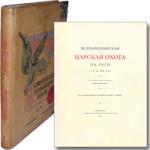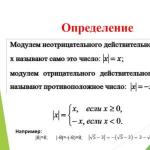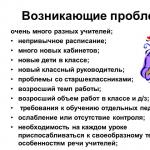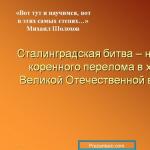2.1 Development of historical thought in Russia from ancient times to late XVII V.
2.2 Origin historical science and the development of domestic historiography in the 18th-19th centuries.
2.3 Features of historiography of the Soviet period.
2.4 Modern domestic historiography.
Historiography– 1) a special historical discipline that studies the development of historical thought and the accumulation of historical knowledge about the development of society; 2) the history of historical science as a whole or its individual periods; 3) a set of studies on a specific problem, for example, the historiography of the Great Patriotic War.
The story began in Ancient Greece. Herodotus, who lived in the 5th century, is considered to be the “father of history.” BC. The works of historians are well known Ancient Rome Plutarch, Tacitus, etc.
Study process national history has come a long way in its development and dates back more than a thousand years, since the emergence of the East Slavic community. The accumulation of historical knowledge itself is divided into 2 stages: pre-scientific and scientific. The pre-scientific stage lasted from the emergence of the East Slavic community (presumably from the 6th century AD) until the turn of the 17th-18th centuries. It is characterized by the fact that historical science did not yet exist in our country, and historical works were of a non-scientific nature.
The second stage of domestic historiography began at the beginning of the 18th century. and continues to this day. It is characterized by the emergence and development of historical science in our country.
2.1 Development of historical thought in Russia from ancient times to the end of the 17th century.
Before the advent of writing among the Eastern Slavs, information about the past was transmitted orally, usually in the form epics- oral epic tales. Epics are the first source about the past. With the advent of writing among our ancestors, historical information began to be recorded in special weather records - chronicles. The events in them were recorded, but not analyzed. They were of a religious nature, since they were conducted by clergy as the most literate people at that time. The most famous ancient Russian chronicler is Nestor (late 11th - early 12th century) - a monk of the Kiev Pechersk Monastery. He is considered the author of the first chronicle, “The Tale of Bygone Years” (circa 1113).
Along with chronicles, literary monuments, such as “The Tale of Law and Grace” by Metropolitan Hilarion, “The Tale of Igor’s Campaign”, etc., are also of great historical importance.
A special type of chronicle writing was hagiography(biographies of saints containing detailed biographical information), otherwise - “Lives of Saints”, for example, “Life of Alexander Nevsky”.
In the 17th century The first printed textbook on Russian history, called “Synopsis,” appeared. Its compiler was the Kiev monk I. Gisel. Until 1861, this textbook was reprinted 25 times. It consisted of excerpts from annals and chronicles, began “from the creation of the world”, and ended with the annexation of Ukraine to Russia.
But all this was not yet scientific historical knowledge.
2.2 The origin of historical science and the development of domestic historiography in the 18th-19th centuries
History as a science originated in Russia in early XVIII century, which is connected with the activities of Peter I. By the end of the reign of Peter I, the Academy of Sciences was organized in St. Petersburg, within which the systematic study of Russian history began in 1725. At the beginning of the academic period, research was carried out by V.N. Tatishchev and G.Z. Bayer.
V.N. Tatishchev was an associate of Peter I. He is considered the first professional historian in Russia. He collected, systematized and compared different versions (lists) of chronicles, and considered history in close connection with the ethnography of countries and territories. The result of his work was the work “Russian History from the Most Ancient Times,” published after his death. The peculiarity of this work is that V.N. Tatishchev used chronicles that have not survived to this day. His work was written almost in the same way as traditional chronicles; the narrative began from the creation of the world. At the same time, a lot of work on criticizing sources (checking the reliability of information) allows us to consider his work the first scientific work.
G.Z. Bayer came to Russia in 1725 and became the founder of the so-called. Norman theory in Russian historiography, according to which the state in Rus' appeared with the arrival of the Varangian princes (another name for the Varangians is the Normans). His views were shared by G.F. Miller and A.L. Schletzer.
M.V. spoke out against the “Norman theory”. Lomonosov, who wrote the “Brief Chronicler”, in which he substantiated the creation of a state in Eastern Slavs without the participation of the Scandinavians. His theory was called anti-Norman.
The controversy surrounding the Norman theory led to increased interest in Russian history, the publication of many historical documents, and the publication of scientific works. IN late XVIII V. The works on Russian history by I.N. received the greatest significance. Boltin, who under Catherine II became famous for his “Notes on the History of Russia by Leclerc.” Leclerc's work absorbed everything negative that could be found in Russian history in order to show the Russian people as non-European and barbaric. In the 18th century recognition of a particular people as “barbarian” meant the need for its forced civilization by turning a “civilized” people into a colony. Such interpretations of Russian history could lead to serious problems in foreign policy.
I.N. Boltin wrote his “Notes” on Leclerc’s work in a short time, in which for each of his examples he found exactly the same example from European, especially French history. I.N. Boltin showed the presence of the same vices in Europe as in Russia, but at the same time successfully showed that the identified shortcomings of Russia are an accident, not a pattern.
TO early XIX century, thanks to the educational activities of Catherine II, the collection of ancient books, the publication of chronicles and documents, historical research have become systematic. However, Russian history was not yet popular and remained the preserve of a narrow circle of scientists and amateur enthusiasts.
The situation was changed by the work of N.M. Karamzin, the first Russian historiographer, who wrote the first work on the history of Russia, the language of which was accessible to a wide range of readers. The first 8 volumes of “History of the Russian State” were published in 1816.
The publication of this book successfully coincided with a change in public opinion among the nobility after the Napoleonic War. If before the Patriotic War of 1812 the nobility extolled European culture and considered the Russian people “vile” and spoke mainly French at court, now, when the peasants “drove the French out of Russia with pitchforks,” a fashion for “Russian” appeared. Karamzin’s work became a “bestseller” and was published in huge editions for its time.
History classes became very popular. Books and magazine publications about Russian history turned out to be an arena of political struggle. First, Slavophiles and Westerners, then liberals and conservatives, tried to confirm their views with varying success with references to Russian history.
The debate between Slavophiles and Westerners, which took place in the 30s and 40s. XIX century, had a positive impact on the development of domestic historical science. Thanks to the Slavophiles - brothers K.S. and I.S. Aksakov, I.V. and P.V. Kireyevsky, Russian ethnography began to develop at an accelerated pace in the country, records of Russian epics, fairy tales, descriptions of customs, etc. appeared. Slavophiles viewed Russian history as exclusively original and extolled the old Russian order. They tried to use information about the veche (people's assembly of the 9th-13th centuries) and Zemsky Sobors (elected government body of the 16th-17th centuries) to agitate the transition to a limited monarchy.
Based on the concept of the Slavophiles in the second half of the 19th century. with the light hand of the Minister of Public Education S.S. Uvarov, a theory of official nationality took shape, which received state support and proclaimed education in the spirit of “Orthodoxy, autocracy, nationality.” The Slavophiles had no less influence on N.Ya. Danilevsky, who substantiated the existence of Russian civilization and placed it on the same level as European civilization.
Westerners abandoned the idealization of Russian patriarchal antiquity and developed historical research in the context of contemporary European concepts. They also supported the idea of abandoning autocracy, but they believed that the basis for future statehood was the development of the legal system and, first of all, the consolidation by law of inalienable human rights, that is, the abolition of serfdom and the adoption of a constitution.
The most famous in this period were the works of representatives of the “state school” and the “Russian school of law”. Among the best representatives of Westerners, we should note such scientists as M.P. Pogodin (“Ancient Russian history before the Mongol yoke”), K.D. Kavelin (“Investigations about the beginning of Rus'”), B.N. Chicherin (“Experiments on the history of Russian law”), S.M. Soloviev (“History of Russia since ancient times”).
Particularly noteworthy are the studies of S.M. Solovyov, who viewed the state as an institution of national interests, highlighted the function of the state as a social institution (protection from external threats), as well as the historical mission of Russia (the struggle between the forest and the steppe). He believed that the oprichnina was just a means of combating tribal relations. In “Public readings about Peter the Great” S.M. Solovyov was the first to express the idea that Peter’s transformations were prepared by the entire course of the historical process.
The works of Russian historians had a significant influence on the preparation of the reform to abolish serfdom, during which, as one of the options, it was proposed to free peasants without land on the basis that the peasants allegedly “roamed” from one land to another (slash-and-burn and shifting systems ) and, therefore, did not have ownership rights to the land. Thanks to the work of representatives of the legal field, direct evidence of the inheritance of land by peasants was found, which forced the landowners of the south of Russia to abandon the idea of depriving peasants of their land.
Turn of the XIX-XX centuries. became the heyday of Russian historical science. The last major study on the history of Russia during this period can be considered the “Course of Russian History” by V.O. Klyuchevsky, whose work in science is exemplary to this day.
Russian historiography in the past and present.
Historiography is a branch of historical science that studies its history. In the historiography of Russia there are several periods:
Pre-Soviet historiography. In 1725, the Academy of Sciences was established in Russia, and Moscow University opened in 1755. It was then that directions in Russian historiography began to take shape. The very first difficulty that historians encountered was the problem of the formation and development of Russian statehood, the origin of the ancient Russian people. The founders of the first concept in Russian historiography in the 17th century. were G. Z. Bayer, G. F. Miller, with whom M.V. categorically disagreed. Lomonosov. The Russian scientist spoke out against the unfounded interpretation of the chronicle about the emergence Old Russian state. These disagreements led to the emergence of two directions in historical science: Normanism and anti-Normanism.
Historical science reached a certain flourishing in the second half of the 18th century, during the era of “enlightened absolutism.” Natural law and social contract theories merged with Western European "Enlightenment" theories. It was proven that monarchy and serfdom were a blessing for Russia, and any attempts to break the existing order were regarded as evil for the country. That's how I understood state development MM. Shcherbatov. An outstanding researcher of Russian antiquity was I.N. Boltin. He was one of the first to comment on the Russian Truth and many other ancient manuscripts. N.M. made an invaluable contribution to the development of history as a science. Karamzin. In 18031826. he worked on creating the “History of the Russian State” in 12 volumes.
In the first half of the 19th century. the formation of the official state historical and ideological theory begins, which was formulated by M.P. Pogodin. This theory was called the official nationality. It traced the unity of “autocracy, Orthodoxy, nationality.” It contributed to the development of the already outdated doctrine of “natural law and social contract” and idealized Russian history.
At the beginning of the 19th century. the Ministry of Public Education was created, universities were opened in St. Petersburg and Kazan; lyceums Tsarskoye Selo and Demidovsky.
In the 20th century A new direction has emerged in science: Eurasianism. The founders of this direction were P.N. Savitsky, N.S. Trubetskoy, G.V. Vernadsky and others. According to the Eurasian doctrine, the people of Russia are doomed to coexistence and close interaction
Significant changes occurred in historical science during the Soviet era, until the end of the 1930s. was at the stage of formation. In 1934–1936, the Marxist-Leninist methodology for studying history was adopted. A great achievement of Soviet historiography was the publication of multi-volume works on the history of the USSR in the pre-Soviet period.Since the mid-80s. XX century, with the beginning of “perestroika” in our country, there was a revision of the historical heritage of the Soviet era. Historiography has been replenished with introductions into scientific circulation some valuable historical sources, especially prominent Russian emigrants, such asON THE. Berdyaev (“The Fate of Russia”, “The History and Meaning of Russian Communism”), I.L. Solonevich ("People's Monarchy").However, highlighting political life the concept of “universal human values” has led to the fact that many historians began to focus more attention on general patterns civilizational development of mankind, adapt, in the words of the great social thinker A.A. Zinoviev, to the “Westernization” of Russia. This especially affected educational literature. This practice of teaching history was condemned in a special resolution of the State Duma on the state and tasks of history education in Russia (1998).
Historiography of Russian history is a multifaceted and ambiguous concept. This is not only a descriptive part, but also a science that studies the formation of historical knowledge over many years. This science has its own subject, tasks, sources, principles and methods. Domestic historiography has its own rich schools and traditions, directions and trends, which, of course, have enriched world historiography and made fundamental changes in the history of science as a whole.
Historiography is divided into several periods. The first of them is pre-scientific. In this period, it is worth studying a person’s perception of time and traditions. Note that during this period, which lasted until the beginning of the 18th century, the main forms of historical storytelling were formed, such as chronicles - keeping records by year. It was this source that became the main one; it was this source that was studied by the historiography of Russian history. When studying chronicles, it is necessary to pay attention to the principles by which they were written, the forms and style in which the works were written. The principle of chronography is especially important, which allows you to compare events, attribute them to certain dates, and connect them in the concept of “earlier” - “later”. The second source during this period that historiographers studied was the lives of saints. It is important to note here that the lives of saints have stronger subjective shades than chronicles - they turn into a kind of legends and stories. Another form of expression of historical consciousness that scientists are interested in is folklore. It is from it that you can learn about people’s ideas about their heroes and enemies. Due to the fact that there are few reliable documents in the pre-scientific period, the issue of the emergence of statehood and the fight against the invaders of Russian land has remained debatable for many years.
The second period of historiography begins in the eighteenth century and lasts until the beginning of the twentieth century. This time had a qualitative impact on the formation and study of the source base. This should include such changes as the secularization of science and the development of not the church, but secular education. For the first time, translated sources imported from Europe are beginning to be processed, historical research as such is being singled out independently, and at the same time, auxiliary disciplines are being formed that help to study history. Qualitatively new stage in this period - the beginning of the publication of primary sources, which largely changed the attitude towards the history of their country, and primarily for the Russian intelligentsia.
It is she, the intelligentsia, who initiates historical expeditions and research. Under the influence of Western trends and philosophical foundations history turns into a full-fledged science. Among the works, it is worth noting the works of F. Prokopovich, A. Mankiev, P. Shafirov, B. Kurakin, G. Bayer, G. Miller, A. Shletser, M. Shcherbatov, I. Boltin, M. Lomonosov. These scientists study the problems of politogenesis, the participation of the Varangians in, etc.
Another stage is the development of historiography in the second third of the nineteenth century. Here, problems such as relations between the Russian state and Western countries are studied, and the first concepts of the development of national history arise.
The fourth stage is the second half of the nineteenth - the beginning of the twentieth century. At this time, the methodological foundations of historiography were being formed. The historiography of Russian history is influenced by positivism, materialism, and neo-Kantianism. The range of research is expanding, with particular attention paid to socio-economic problems in history. At the fourth stage, the question arises about vocational training historical footage.
The last fifth stage is the Soviet historiography of Russian history, which is based on the class approach to the development of society, which, in turn, was reflected in the scientific approach. Overcoming the Soviet legacy is the main goal of the modern historical school.
Methods of history
General history methods:
– sociological method – emphasis on the history of society;
– anthropological (or historical-anthropological) method– primary attention to man in history;
– genetic– study of a phenomenon from its inception through the process of development and bringing it to a certain state;
– ideographic- description historical events and phenomena;
– problem-chronological– study of the sequence of historical events in time;
– retrospective– consistent penetration into the past in order to identify the causes of events;
– synchronous– study of historical events occurring at the same time;
– comparative) – comparison of historical objects in space and time;
– typological– classification of historical phenomena, events and objects;
– systemic– disclosure of internal mechanisms of functioning and development;
– structural-functional– explores not only stable elements that provide specificity structural systems, but also those functions that individual elements perform;
– techniques and methods of quantitative analysis– correlation analysis, factor analysis, etc.
Private, actually historical methods:
– modeling of historical situations;
– a group of methods for analyzing historical sources.
Historiography as a science that studies the process of accumulation of historical knowledge, as self-knowledge of history, appeared recently (mid-19th century). It describes all previously existing historical knowledge. First Russian experience- a course of lectures by S.M. Solovyov (1848-49) on historical literature.
Stages Russian history like science:
· pre-scientific(before mid-17th century century) - time oral traditions, epics, sagas Some of them were written down over time and in this form have survived to this day. Actually epics - the first sources carrying information about the past. Later, historical information began to be recorded - chronicles(the first historical works that contained information that the chronicler managed to find out). Historical works of the pre-scientific period also include lives of saints and chronicles;
· scientific(from the middle of the 17th century) - works on history appeared, where the authors not only describe events, but also try to analyze them. Many of these works are related to the activities of Peter I. For example, the work of Prince Boris Ivanovich Kurakin(1676 -1727), participant in the Azov campaigns and Northern War, who commanded the Semenovsky regiment in the Battle of Poltava. The work was called "History Russian Empire", about a third of the narrative is devoted to the pre-Petrine era, and the rest to the events of the reign of Peter I (with comments from the participating author).
The beginning of professional historical science in Russia was laid by the works of the Germans who worked with us - the historian Gottlieb Siegfried Bayer(1694-1738) and August Schlozer(1735-1809). These scholars pioneered the use of specialized historical methods to extract reliable information from historical sources.




